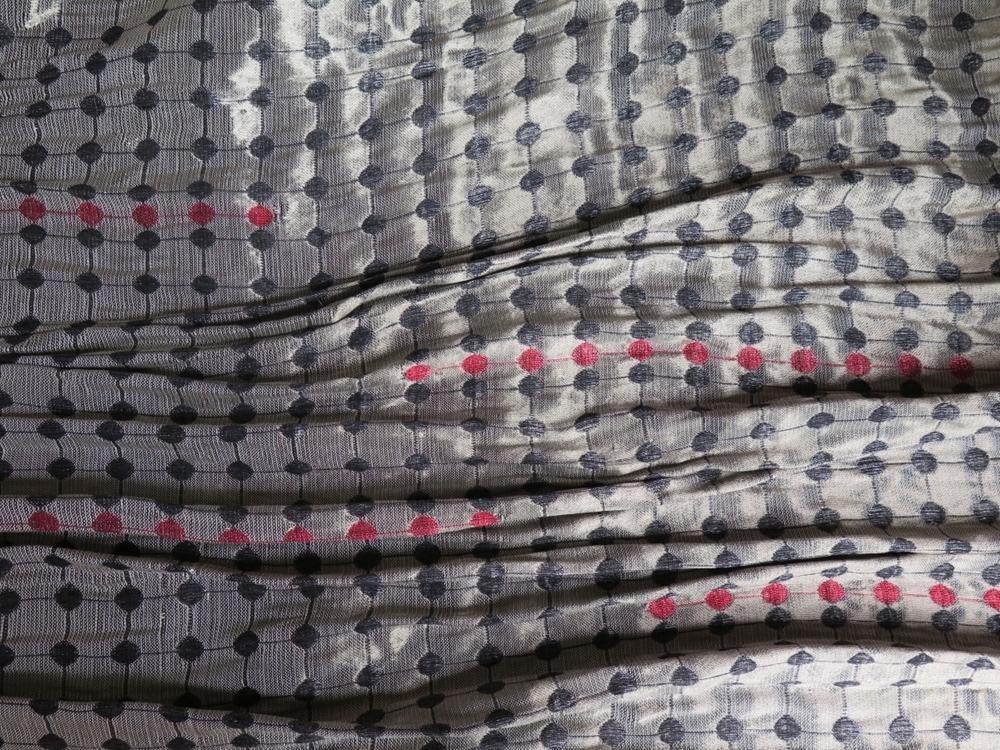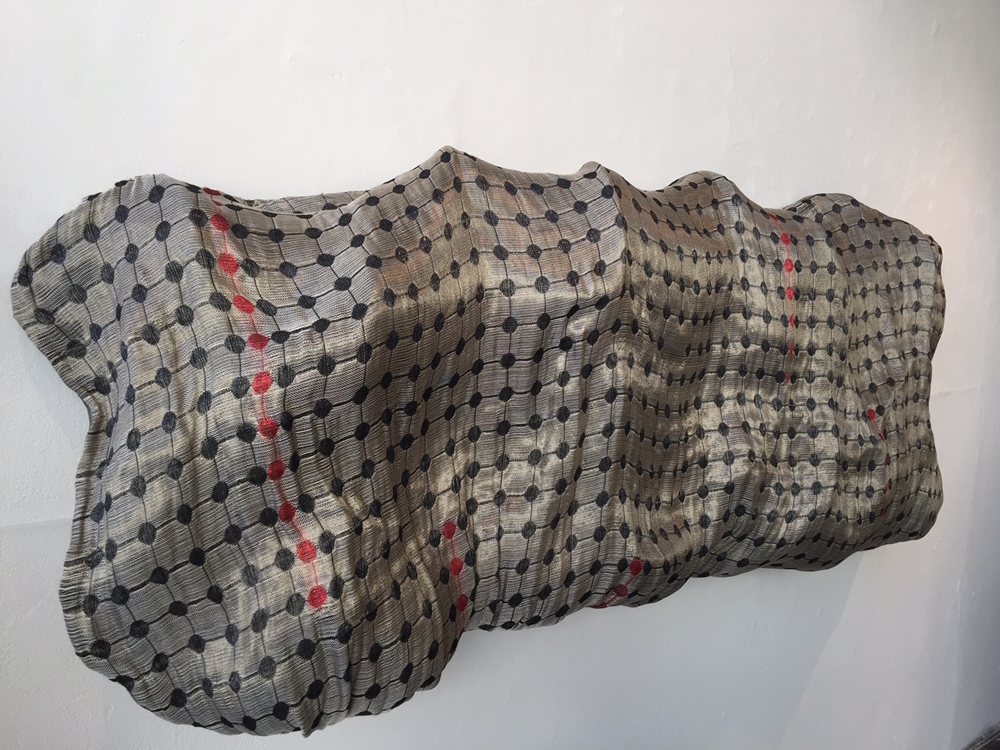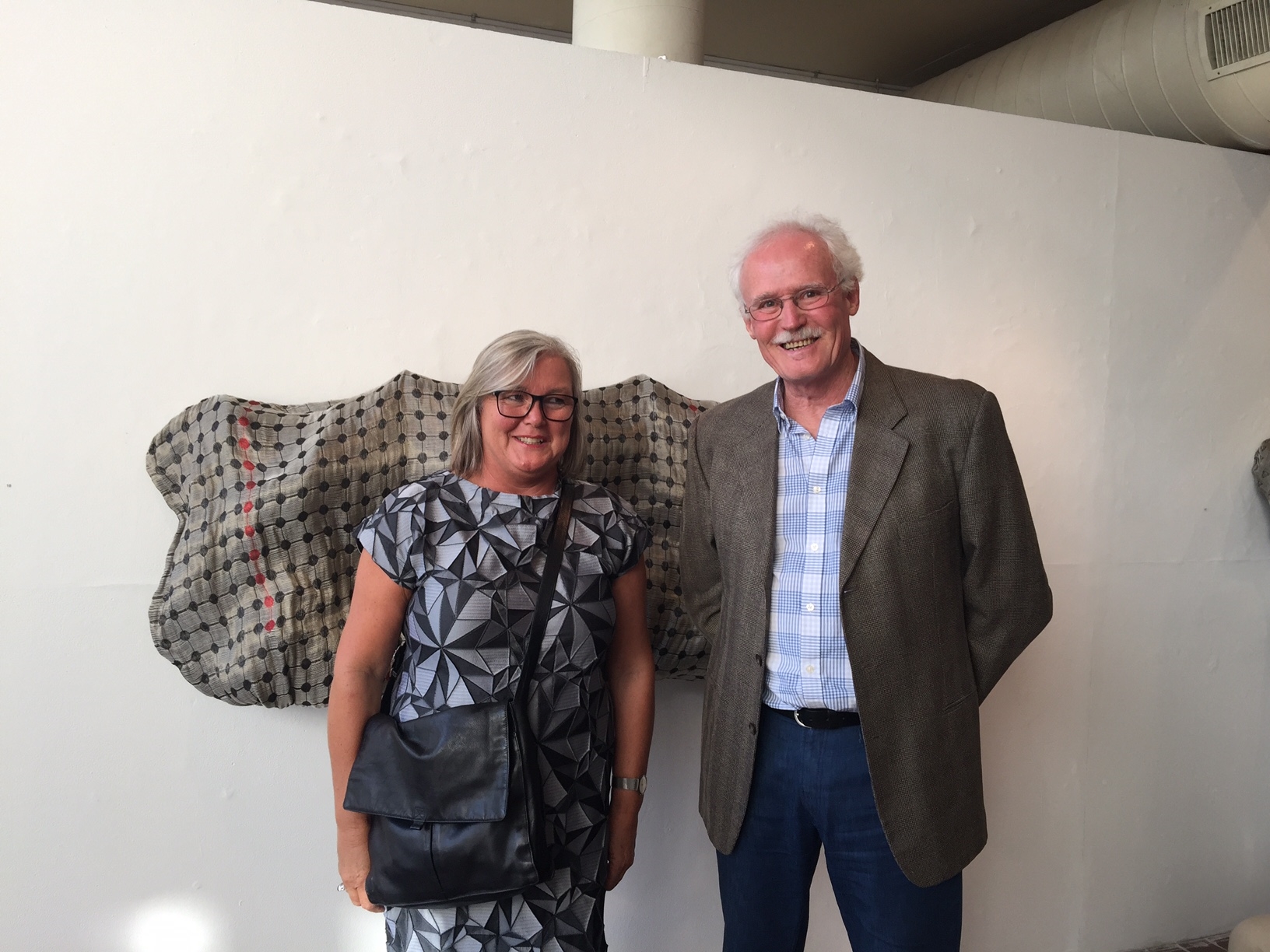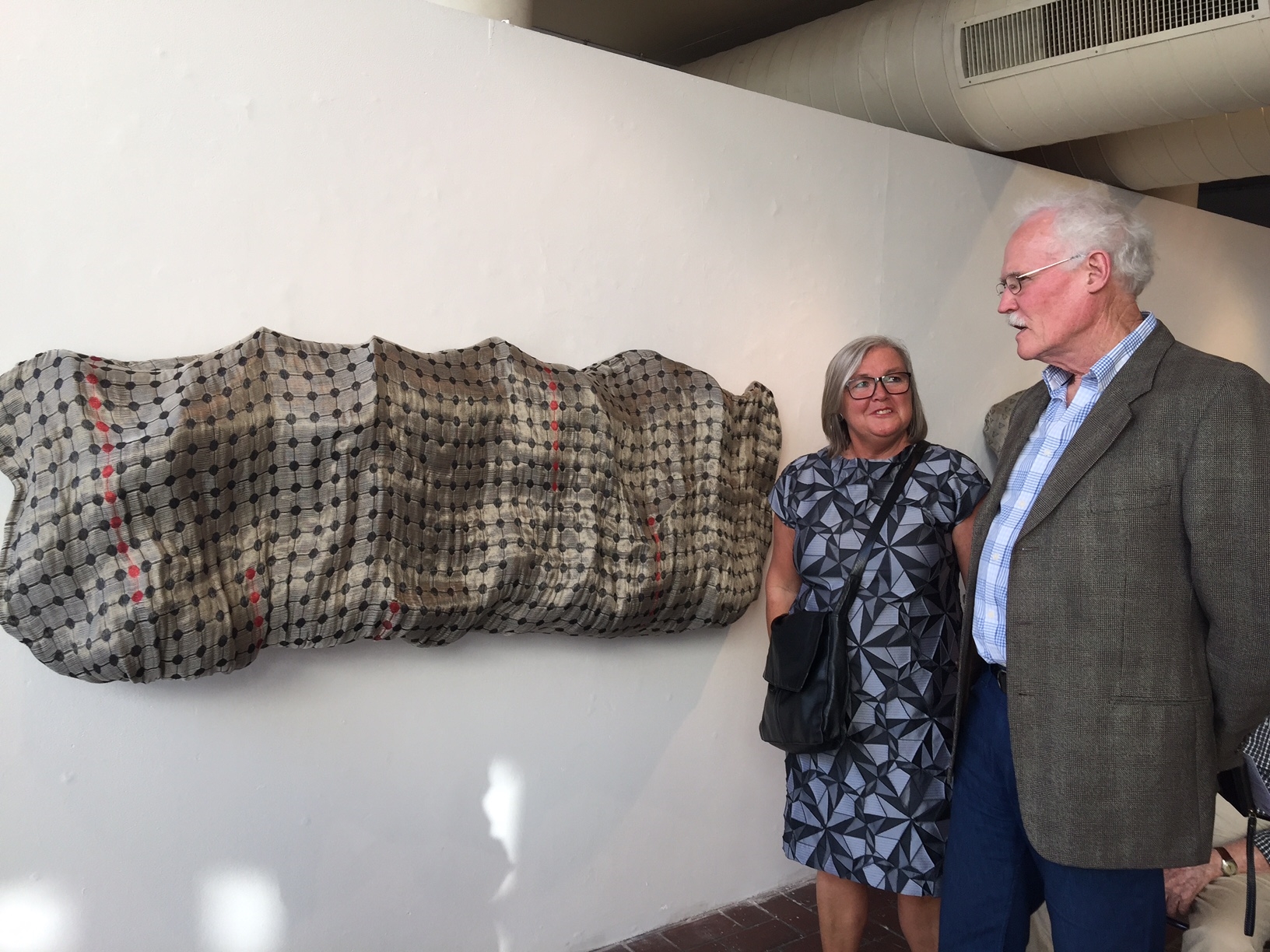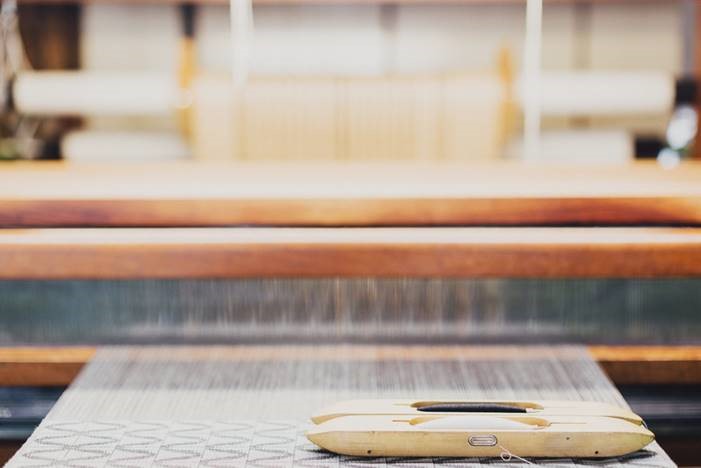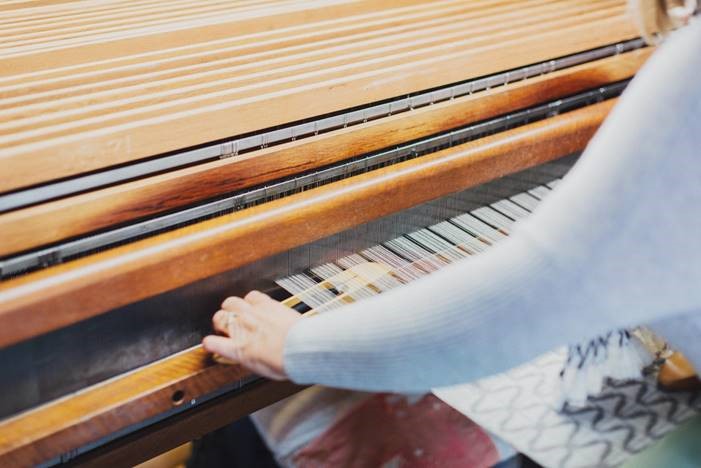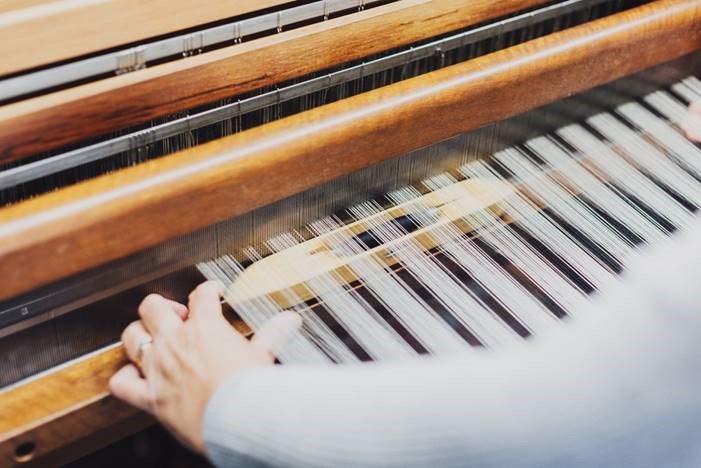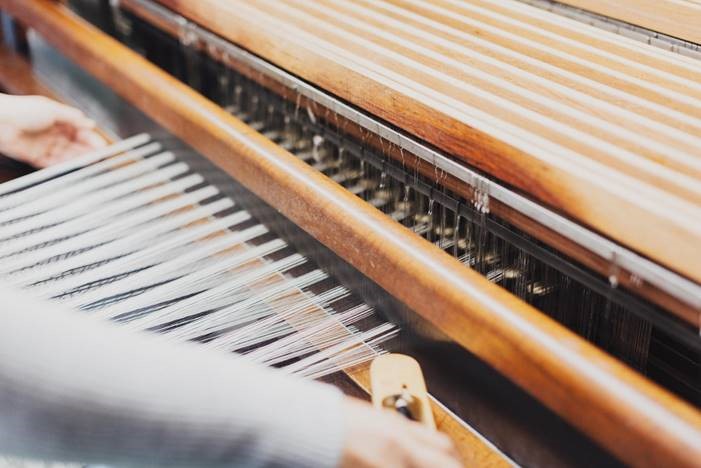Art donation explores connections between geology and weaving
The first scheme of its kind in an Australian university, the Vice – Chancellor’s College Artist Fellows Scheme (VCCAFS) supports interdisciplinary research relationships. It offers an exciting opportunity for creative artists to work with researchers in other fields.
Internationally renowned woven textile specialist, Jennifer Robertson, chose to collaborate with Ian Jackson (RSES) and his scientific research. The results: two exquisite woven textiles: Crystal Imperfections as Agents of Deformation and Tetrahedrons in Olivine.
Jennifer Robertson has very generously donated Crystal Imperfections as Agents of Deformation to RSES for the earth sciences community to enjoy. It is a wonderful example of what can be achieved around interdisciplinary research.
The process of collaboration: statements from the artist and the scientist
Artist statement
Jennifer Robertson’s textile research focuses on exploring meaningful connections, correlations and analogies between geology and weaving. Geology, with its outward forms and surfaces is informed by what is normally unseen in its molecular and atomic structures.
Fostering a first-time collaboration with the Research School of Earth Science (RSES) and Emeritus Professor Ian Jackson has facilitated a new, meaningful dialogue between geology and weaving. Specifically, we have focused upon RSES pivotal research into “defects” or “flaws” – vacant sites and dislocation lines running through atomic and molecular crystal lattice structures of minerals such as olivine.
Paradoxically, “defects” in weaving are always unwanted and every attempt is made to eradicate them at every stage of the preparation and weaving process. This in itself presented an interesting challenge – how to make defects intentional, intrinsic and the focus of aesthetic, technical and physical research in cloth. Early on in the project I was drawn to the many scientific symbols, grids and diagrams used to portray, educate and convey information about different aspects of mineral structures.
Weaving is inherently a grid system with horizontals and verticals, intersecting to form intrinsic pattern and structure based upon math. After some experimenting, I responded by weaving double-cloth disrupted pattern and structure to form dislocation faults, highlighted in red copper over an olivine grid structure.
Guiding the physical and aesthetic approaches to weaving has included international sourcing of key mineral fibres such as basalt, glass, stainless steel, copper and silver. Each of these fibres has its own set of technical requirements in the weaving process, leading to between four to six shuttles thrown across the loom in the weft for every row of visible weaving, each one demanding different treatment as behaviour varies radically. Weaving rock seems absurd yet has offered exciting and strategic new directions for my practice–led research in woven textiles.
Approaching the collaborative research project with a scientifically correct perspective offered clarity - of parameters, purpose and outcome. Whilst some introduction time was needed at the start, the project quickly developed into an inventive and creative collaboration that has highlighted the strategic nature of research focussing on natural defects, deformations faults and flaws.
Collaborator statement
Lattice defects as the agents of deformation
Emeritus Professor Ian Jackson’s scientific research is well-described as “rock whispering” – an activity which involves coaxing out of rocks the closely-guarded secrets concerning their mechanical behaviour. This is done through laboratory experiments under controlled conditions of pressure, temperature and stress, which simulate those prevailing within the Earth’s deep interior.
The mechanical properties of rocks are of central interest in geophysics, both in understanding the structure of the Earth’s interior as revealed by seismic waves and its capacity to deform like a viscous fluid on the long timescales of plate tectonics.
Some physical properties of minerals and rocks are determined by the way in which the constituent atoms are packed into regular arrays called crystal lattices. However, the high-temperature mechanical behaviour of rocks is controlled by defects or flaws in the regular packing of atoms in crystalline minerals. These defects range from vacant lattice sites which create space for the migration of atoms through crystal structures, through line defects called dislocations which move under stress to allow crystals to change their shape, to grain boundaries grains which are zones of weakness that allow deformation by relative movement between adjacent grains.
The weaving by Jennifer Robertson is evocative of both the overall regularity of the atomic arrangements within the crystalline lattice and also the presence of flaws or defects in the crystalline structure. Such defects are the agents of high-temperature deformation, facilitating the slow convective stirring of the Earth’s crystalline silicate mantle, that is expressed at the surface in the movements of the tectonic plates.
Artist biography
Jennifer Robertson studied at West Surrey College of Art and Design, Royal College of Art, UK and Fondazione Arte della Seta Lisio, Florence, Italy. In 1987 she established a weave studio in Fremantle, WA and joined the staff at ANU School of Art, Canberra in 1997. Jennifer is an internationally renowned woven textile specialist and researches, lectures and exhibits nationally and internationally. Research highlights include a two year Australia Council Visual Arts Fellowship 2001-2003 and one year ArtsACT Creative Fellowship 2005. In 2016, Jennifer Robertson exhibited and presented at the 11th International Biennial Contemporary Textile Art Exhibition Scythia, in Kherson, Ukraine and at “From Lausanne to Beijing 9th International Fiberart Biennial”, Shenzen, China. Her work is included in numerous public, private international and national collections, including the Cooper Hewitt Smithsonian Design Museum, New York, USA, NUNO Corporation, Tokyo, Japan and National Gallery of Australia

